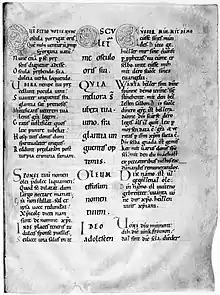Williram of Ebersberg
Williram of Ebersberg (died 3 January 1085) was a Benedictine Abbot. He is best known for his 'Expositio in Cantica Canticorum', a complex commentary of the Song of Songs which includes an Old High German translation and a Latin verse paraphrase.

Biography
Williram came from a noble family in the Rhine area, related, among others, to the archbishop Heribert of Cologne (999–1021), the Würzburg bishop Heinrich (995–1018), and the Eichstätt bishops Heribert (1022–1042) und Gezemann (1042). Ca.1020, he entered the Benedictine monastery Fulda, then in the 1040s became teacher in the Benedictine monastery Michelsberg in Bamberg, together among others with bishop Suidger, the future pope Clemens II. (1046–1047). Williram belonged to the court circle of emperor Henry III (1039–1056). In 1048, he became abbot at the Benedictine monastery of Ebersberg where he remained until his death 1085. He was a friend of the Benedictine abbot Wilhelm of Hirsau for whom he wrote a new version of the Life of Saint Aurelius, the patron saint of Hirsau.[1]
In the preface to his Expositio which he dedicated to Henry IV, Williram laments that, in Germany, grammar and dialectics are more popular than Biblical studies, praises Lanfranc devoting himself to the deeper study of the Bible and drawing many German scholars to France. The pages of his work are divided into three columns: The first contains a Latin paraphrase in Leonine hexameters of the Vulgate followed for each of the 150 paragraphs of the Song of Songs by a paraphrase of the prose commentary on the right hand side column; the second, the Vulgate text; and the third, an Old High German prose translation followed by a commentary in Latin-German mixed prose exposition. Williram describes his text as supporting the "body" of the Bible text which is marked up with the 'voces' of Christ, the Synagogue and the Church.[2]
Williram is believed also to be the author of the Chronicon Eberspergense, a set of monastic annals included in the Ebersberg cartulary, which he also compiled.[3]
Transmission
Williram's commentary is the Old High German text with the highest number of surviving manuscripts, right up to the print tradition.[4] It is remarkable that two manuscripts are extant which were probably written during his lifetime in the Abbey of Ebersberg. One of these, the codex Bayerische Staatsbibliothek Cgm 10, contains also his Latin poems.[5] About 1100, an Old Dutch adaptation of Williram's commentary was produced.[6]
The editio princeps of the Expositio, based on the Leiden manuscript, was published in 1598 by the librarian of Leiden University Library, Paulus Merula. Merula omitted the prologue, though it was in the Leiden manuscript, so Martin Opitz printed this in his Annolied edition of 1639.[7] It appears that the Annolied and Williram's Expositio were transmitted together on a number of occasions.
See also
Notes
- Discussion and edition of this in Henrike Lähnemann: Reimprosa und Mischsprache bei Williram von Ebersberg. Mit einer kommentierten Ausgabe und Übersetzung seiner 'Aurelius-Vita', in: Deutsche Texte der Salierzeit - Neuanfänge und Kontinuitäten im 11. Jahrhundert, ed. by Stephan Müller and Jens Schneider, München 2010 (Mittelalter Studien 20), pp. 205-237 Open access pre-print
- On the layout and its literary implications cf. Henrike Lähnemann: Neniae meae, quas in Cantica canticorum lusi. The poetic and aesthetic treatment of the Song of Songs by Williram of Ebersberg, in: Il Cantico dei cantici nel Medioevo. International Conference of the Società Internazionale per lo Studio del Medioevo Latino (S.I.S.M.E.L.), ed. by Rossana Guglielmetti, Florence 2008, pp. 255-276.
- Graeme Dunphy. "Williram of Ebersberg." Encyclopedia of the Medieval Chronicle. Brill Online , 2012. Reference. 18 May 2012 <http://referenceworks.brillonline.com/entries/encyclopedia-of-the-medieval-chronicle/williram-of-ebersberg-SIM_00572>
- List of manuscripts in Henrike Lähnemann / Michael Rupp: Von der Leiblichkeit eines ›gegürteten Textkörpers‹. Die ›Expositio in Cantica Canticorum‹ Willirams von Ebersberg in ihrer Überlieferung, in: Text und Text in lateinischer und volkssprachiger Überlieferung des Mittelalters (Wolfram-Studien 19), Berlin 2006, ed. by Eckart Conrad Lutz, pp. 96-115 Open Access pre-print.
- online http://daten.digitale-sammlungen.de/~db/0005/bsb00059252/images/
- W. Sanders, Der Leidener Willeram. Munich, 1974.
- Graeme Dunphy, Opitz's Anno, Glasgow 2003, p. 48-50.
![]() This article incorporates text from a publication now in the public domain: Herbermann, Charles, ed. (1913). Catholic Encyclopedia. New York: Robert Appleton Company.
This article incorporates text from a publication now in the public domain: Herbermann, Charles, ed. (1913). Catholic Encyclopedia. New York: Robert Appleton Company. {{cite encyclopedia}}: Missing or empty |title= (help)